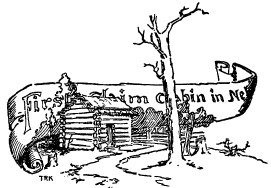|
Humble Homes Were Built |
|
|
"Thus it is our daughters leave us, |
|
|
|

|
|
|
64 |
|
|
|
|
Florence and are told the original vaults remain,
although the building has been improved and enlarged. In the
town park stands a grand old elm said to have been planted
by Brigham Young. |
|
|
|
|
65 |
|
|
Settlers began coming in so
fast, it was evident that this vast country was of great
value to the nation, and the people began to look to the
question of legislation. After several attempts and failures
to secure recognition, Stephen A. Douglas, in 1854,
introduced into Congress the Kansas-Nebraska bill, which,
from its slavery clause, tore the nation asunder, but
finally passed both Houses, the slave question being left to
the citizens, but before they were called on to adopt the
Constitution, the slavery question was settled by the Civil
War. |
|
|
66 |
|
|
|
|
but the Presbyterian Mission demanded $50,000.00 for the
land the Governor wished for capital purposes. Great rivalry
existed among the towns as to the location of the capital,
and great indignation was felt when the first legislature
convened in Omaha on January 16, 1855, in a brick building
built for the purpose on Ninth between Farnam and Douglas
streets, the location of which was recently marked with a
bronze tablet by the Nebraska Society of Colonial Dames. |
|
|
|
|
67 |
|
|
tables were scarce in those days, it was passed around,
after which the Governor, with chattering teeth, made a
speech and the first inaugural ball became history. |
|
|
68 |
|
|
|
|
Platte sections in Nebraska were hostile to each other
and bitter strife resulted. The South Platte country
attempted to secede and become a part of Kansas, but by the
Wyandotte convention this was averted, as the citizens of
Kansas were having troubles of their own and did not care to
annex a country largely democratic, so the southern boundary
line of Nebraska remained and became fixed at 40 degrees of
latitude. |
|
|
|
|
69 |
|
|
The first State Legislature
named a commission consisting of Governor Butler, Secretary
of State, and the Auditor, to select not less than six
hundred and forty acres of land on which should be located
the state capitol, university and state penitentiary, the
town to be called Lincoln. They selected a site in Lancaster
County, and proceeded in 1868 to erect the state buildings
of the new State of Nebraska, having secured nine hundred
and sixty acres of land for state use. |
|
 |
 |
 |
MARDOS COLLECTION
© 1999, 2000, 2001 for the NEGenWeb Project by Pam Rietsch,
T&C Miller